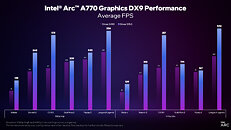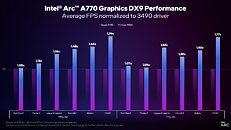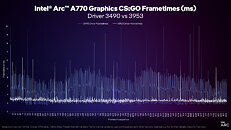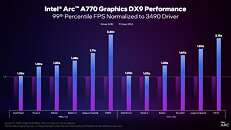- Joined
- Oct 9, 2007
- Messages
- 47,290 (7.53/day)
- Location
- Hyderabad, India
| System Name | RBMK-1000 |
|---|---|
| Processor | AMD Ryzen 7 5700G |
| Motherboard | ASUS ROG Strix B450-E Gaming |
| Cooling | DeepCool Gammax L240 V2 |
| Memory | 2x 8GB G.Skill Sniper X |
| Video Card(s) | Palit GeForce RTX 2080 SUPER GameRock |
| Storage | Western Digital Black NVMe 512GB |
| Display(s) | BenQ 1440p 60 Hz 27-inch |
| Case | Corsair Carbide 100R |
| Audio Device(s) | ASUS SupremeFX S1220A |
| Power Supply | Cooler Master MWE Gold 650W |
| Mouse | ASUS ROG Strix Impact |
| Keyboard | Gamdias Hermes E2 |
| Software | Windows 11 Pro |
Intel Arc "Alchemist" graphics architecture was originally developed as a forward-facing PC GPU architecture with many of the contemporary graphics technologies, including full DirectX 12 Ultimate support, however, the GPU curiously lacks hardware support for DirectX 9. Released 20 years ago, DirectX 9 continued to power AAA PC titles well into the 2010s as game console development lagged (the era of Xbox 360 and PlayStation 3), and most e-sports titles of the time included either native or fallback DirectX 9 support for those on older GPUs. This is a problem for Intel, as many of the currently-popular e-Sports titles may still use DirectX 9, and so the Intel Graphics team set out to individually optimize DirectX 9 titles with each new Arc GPU driver release.
While Arc GPUs lack DirectX 9 support, foolproof API translation technologies exist, which convert DirectX 9 API instructions into DirectX 12. This is not fundamentally unlike how 32-bit applications work on 64-bit Windows (using WOW64 machine-architecture translation). This, however, requires per-game optimization to ensure any engine-level special features are correctly translated. With the latest 101.3959 Beta drivers, Intel optimized popular DirectX 9 titles "League of Legends," "Counter Strike: Global Offensive," "Starcraft 2," "Payday 2," "Guild Wars 2," "Stellaris," "NiZhan," and "Moonlight Blade." The company seems to be going about this the smart way, by relying on market analysis for selecting the games in need of optimization (understanding what DirectX 9 games are still being played).




"We use a hybrid approach, i.e., a combination of API techniques, to take advantage of translation layers when a better experience can be delivered using one of our more modern API implementations. These improvements will be delivered transparently to the end user through our normal driver distribution process. The details of this implementation may change over time as our DX9 driver evolves," said Ryan Shrout, the technical marketing head at Intel. The company even provided a selections of benchmarks to show how its optimization efforts translate into much better real-world performance, than simply applying DirectX 9 to 12 API translation (without game-specific optimization). The company will continue to add more titles to this list with future releases of its Arc GPU drivers. Below is a video presentation detailing these optimization efforts.
View at TechPowerUp Main Site | Source
While Arc GPUs lack DirectX 9 support, foolproof API translation technologies exist, which convert DirectX 9 API instructions into DirectX 12. This is not fundamentally unlike how 32-bit applications work on 64-bit Windows (using WOW64 machine-architecture translation). This, however, requires per-game optimization to ensure any engine-level special features are correctly translated. With the latest 101.3959 Beta drivers, Intel optimized popular DirectX 9 titles "League of Legends," "Counter Strike: Global Offensive," "Starcraft 2," "Payday 2," "Guild Wars 2," "Stellaris," "NiZhan," and "Moonlight Blade." The company seems to be going about this the smart way, by relying on market analysis for selecting the games in need of optimization (understanding what DirectX 9 games are still being played).




"We use a hybrid approach, i.e., a combination of API techniques, to take advantage of translation layers when a better experience can be delivered using one of our more modern API implementations. These improvements will be delivered transparently to the end user through our normal driver distribution process. The details of this implementation may change over time as our DX9 driver evolves," said Ryan Shrout, the technical marketing head at Intel. The company even provided a selections of benchmarks to show how its optimization efforts translate into much better real-world performance, than simply applying DirectX 9 to 12 API translation (without game-specific optimization). The company will continue to add more titles to this list with future releases of its Arc GPU drivers. Below is a video presentation detailing these optimization efforts.
View at TechPowerUp Main Site | Source



